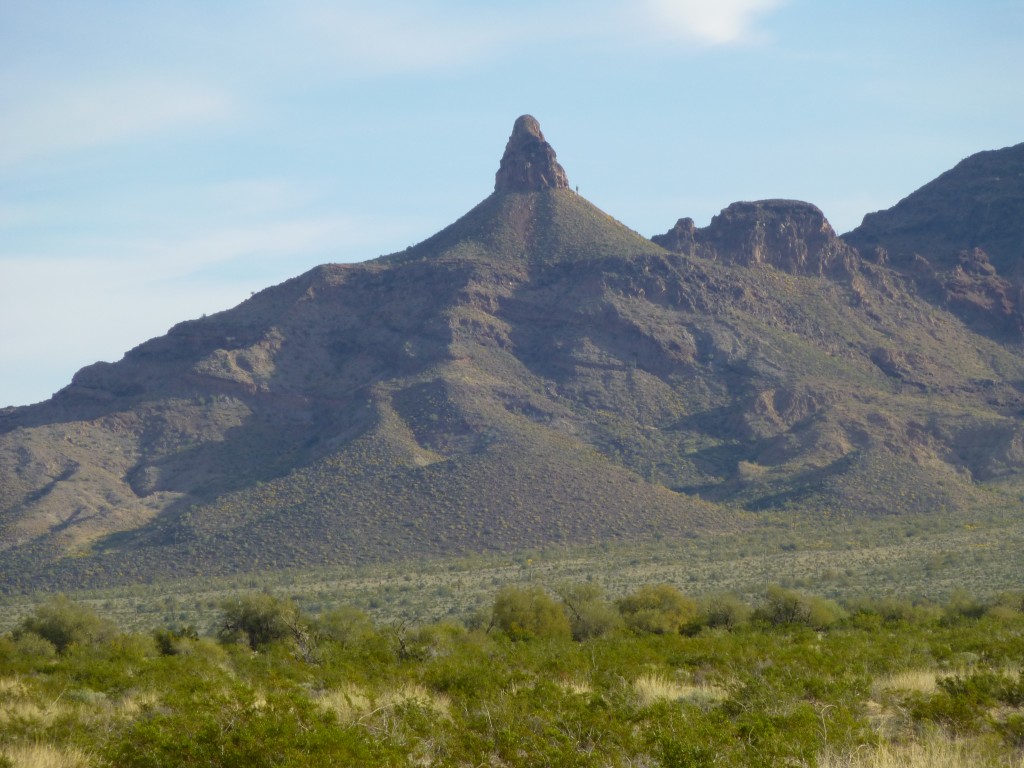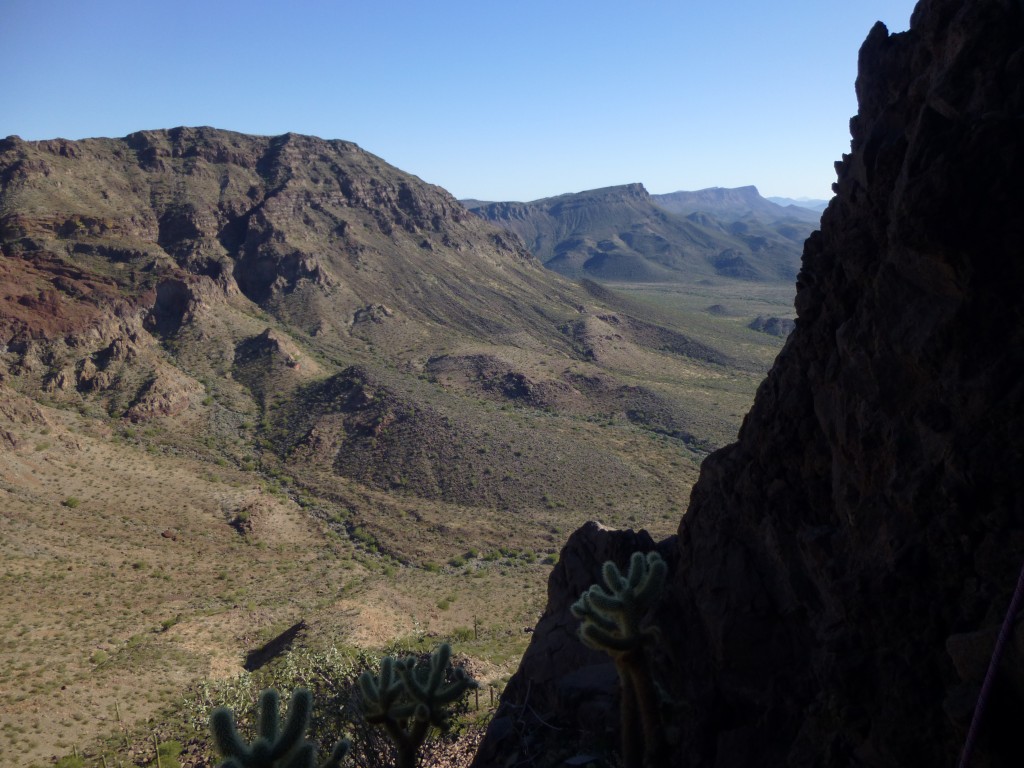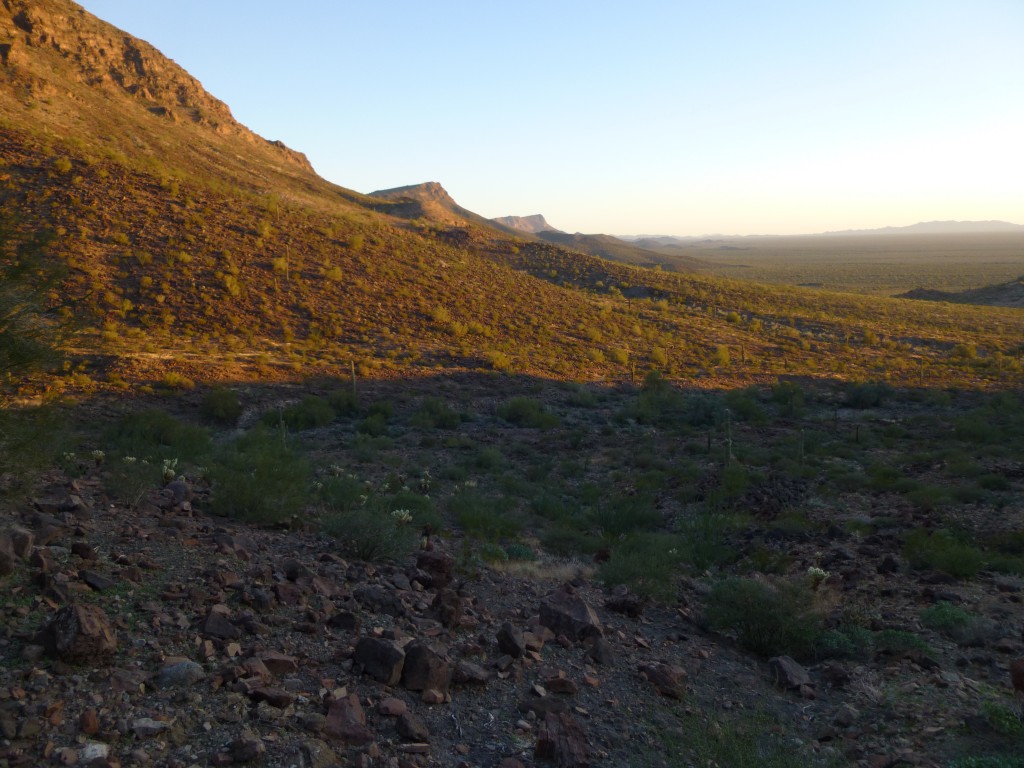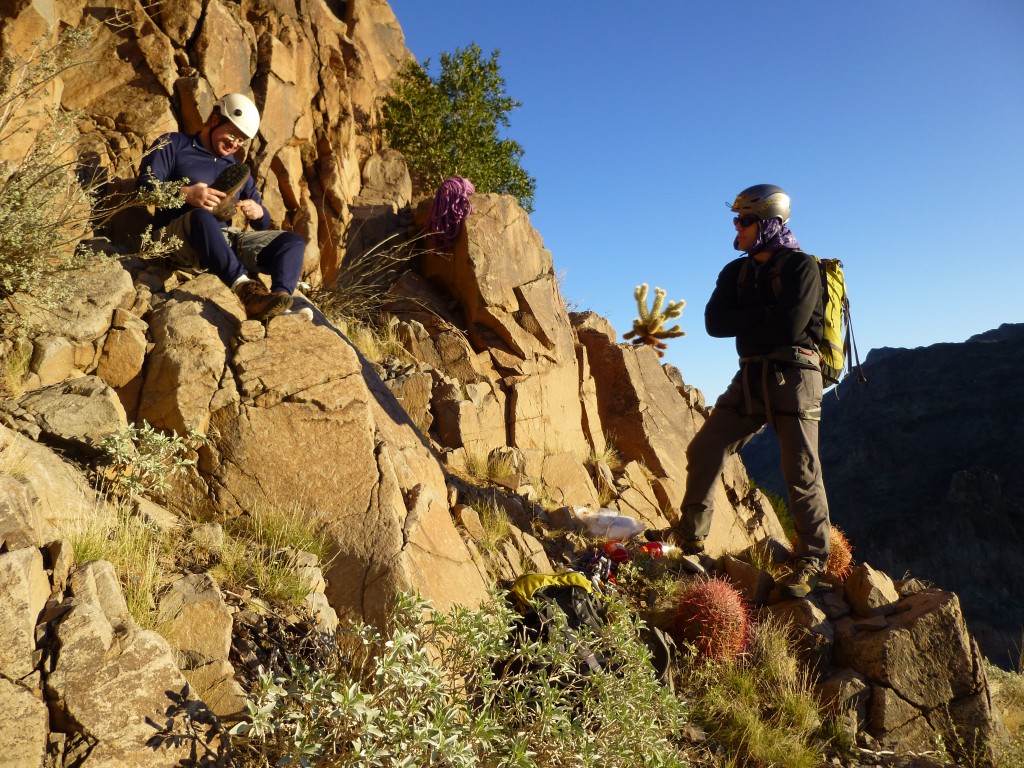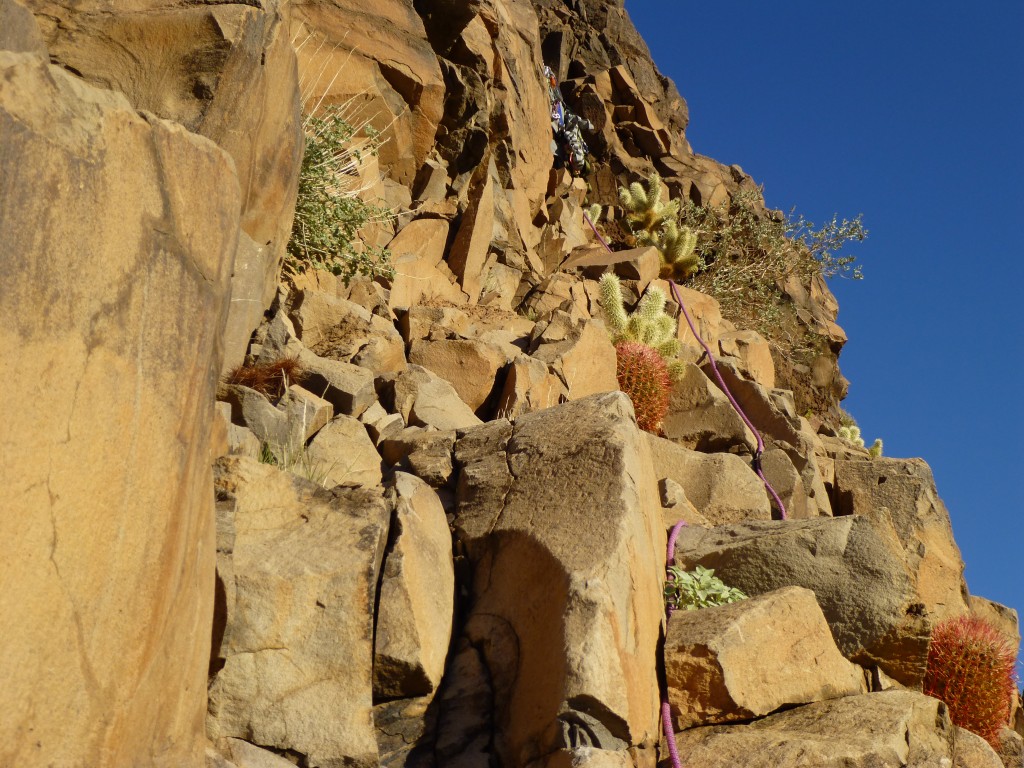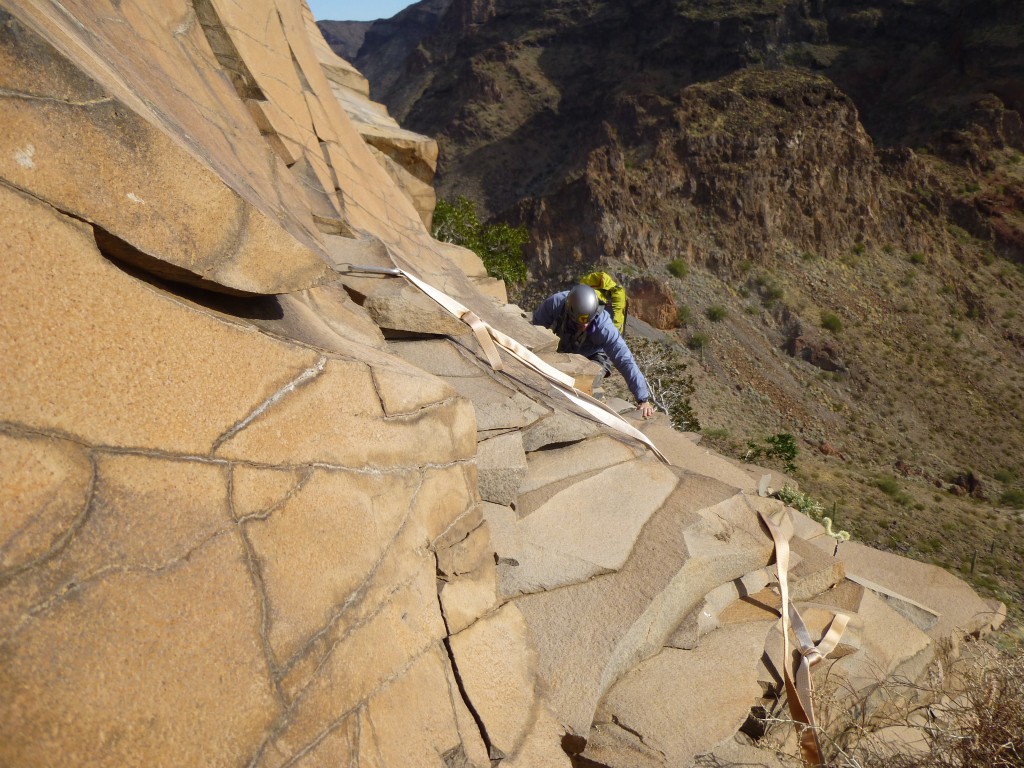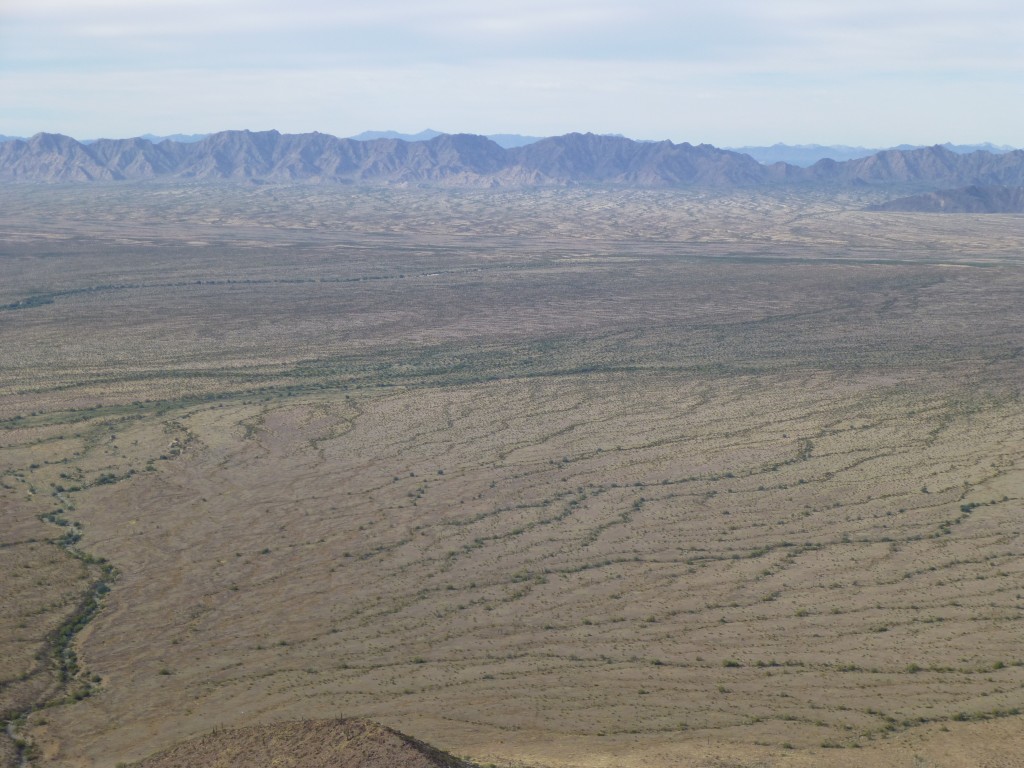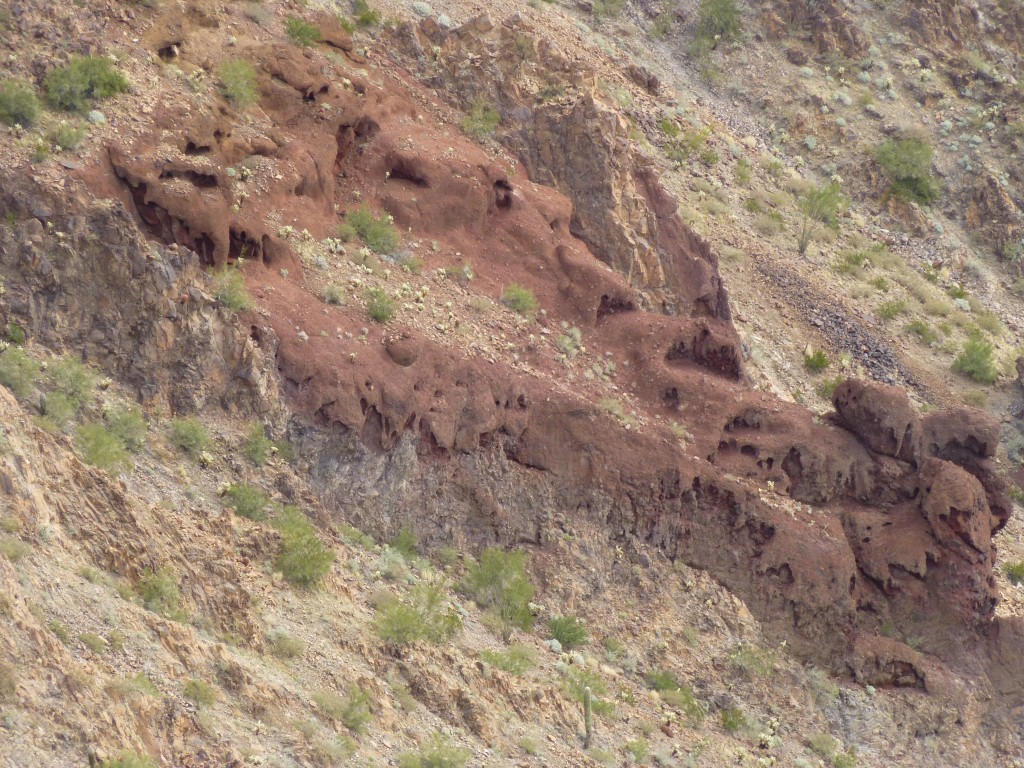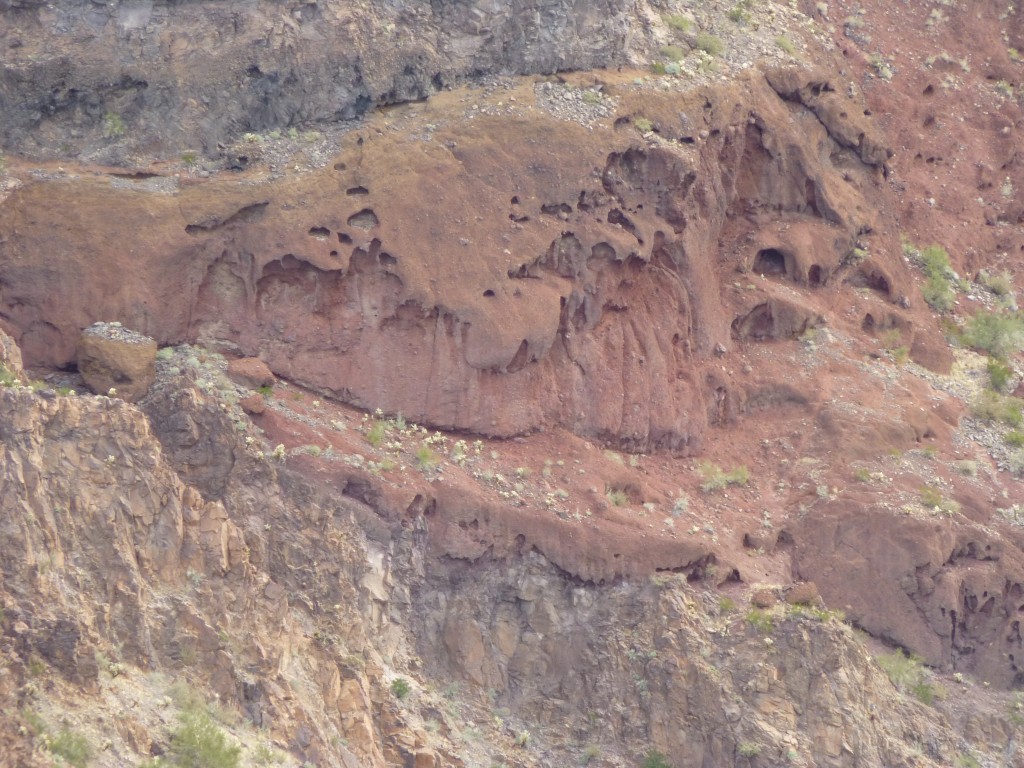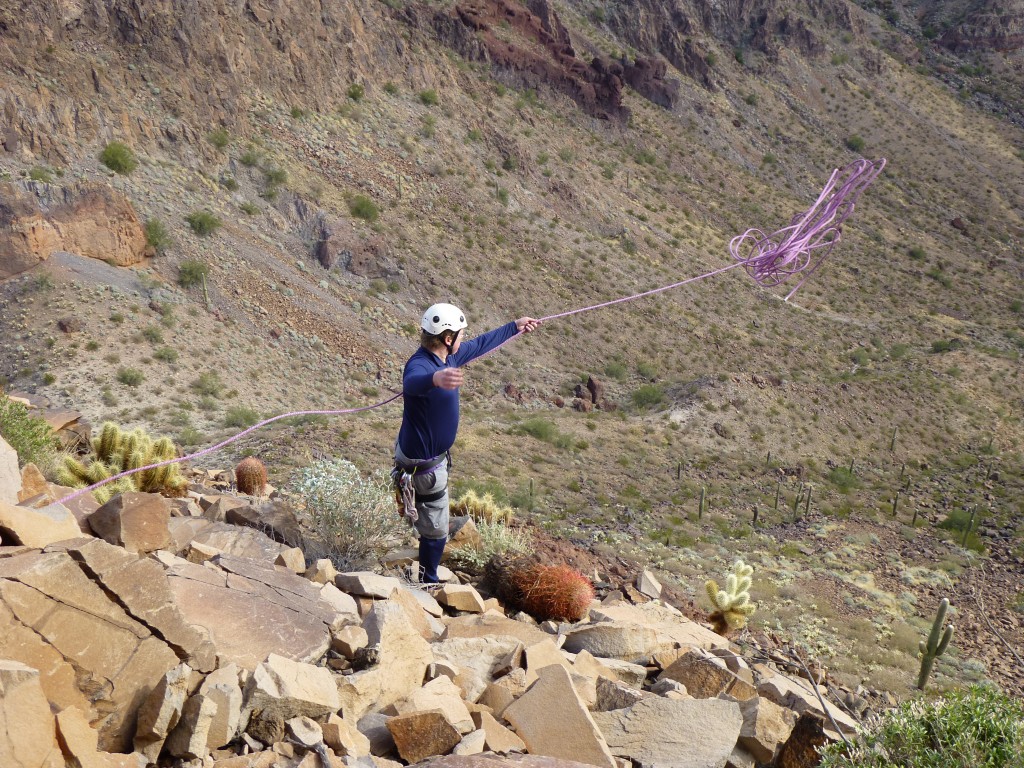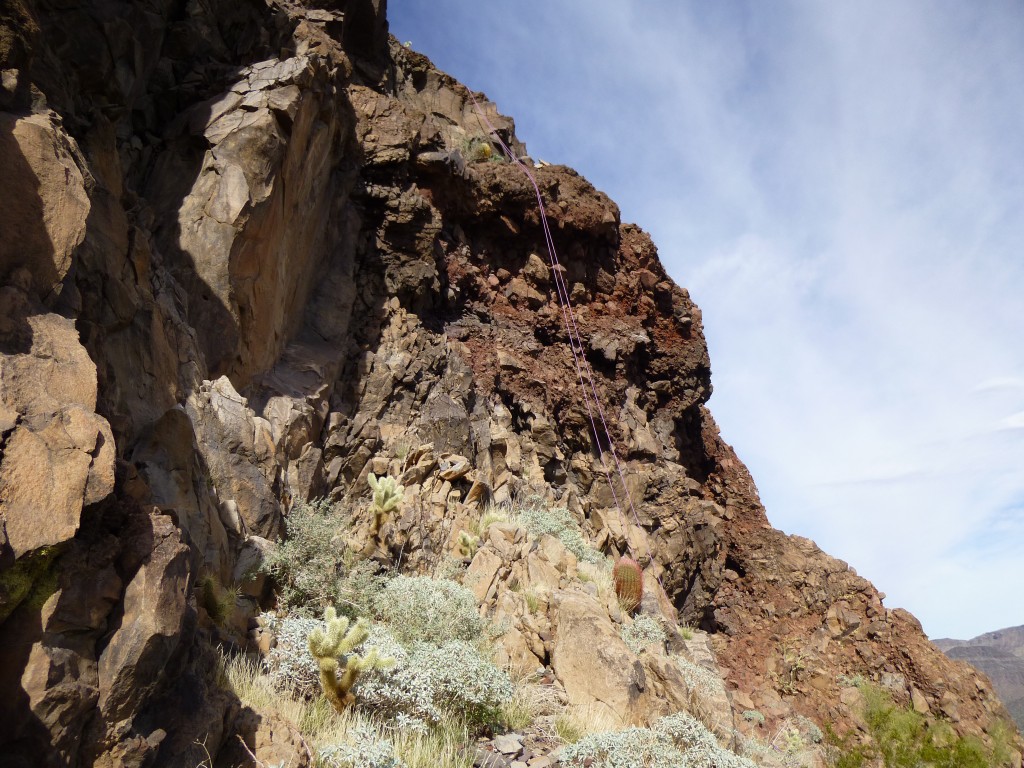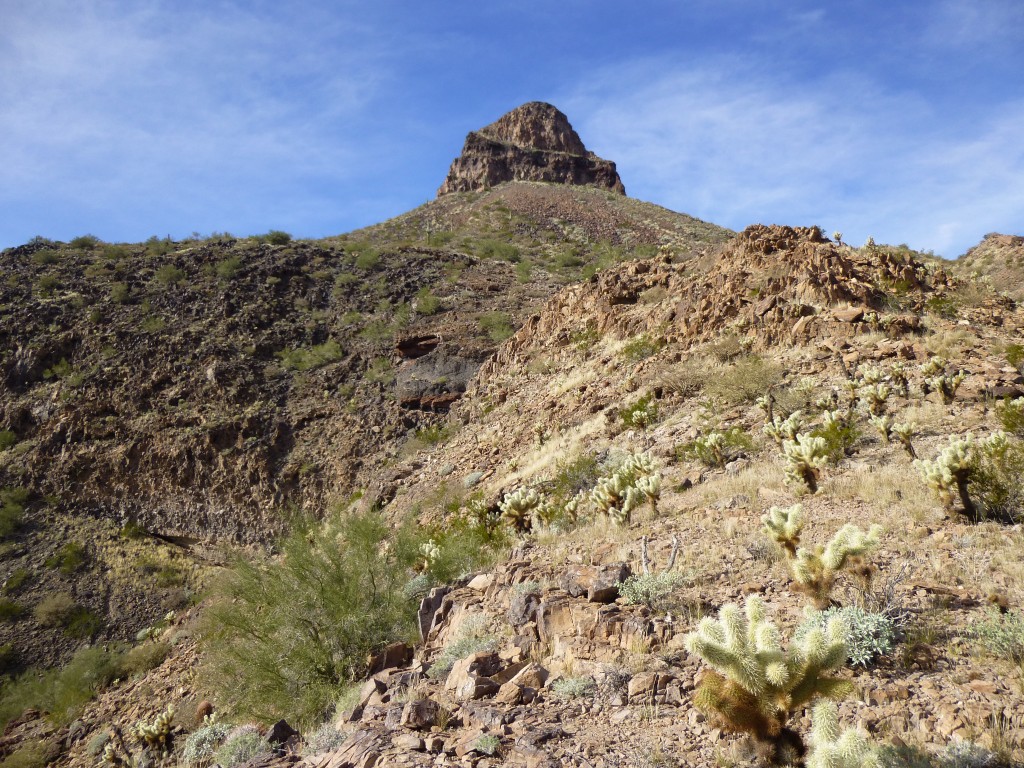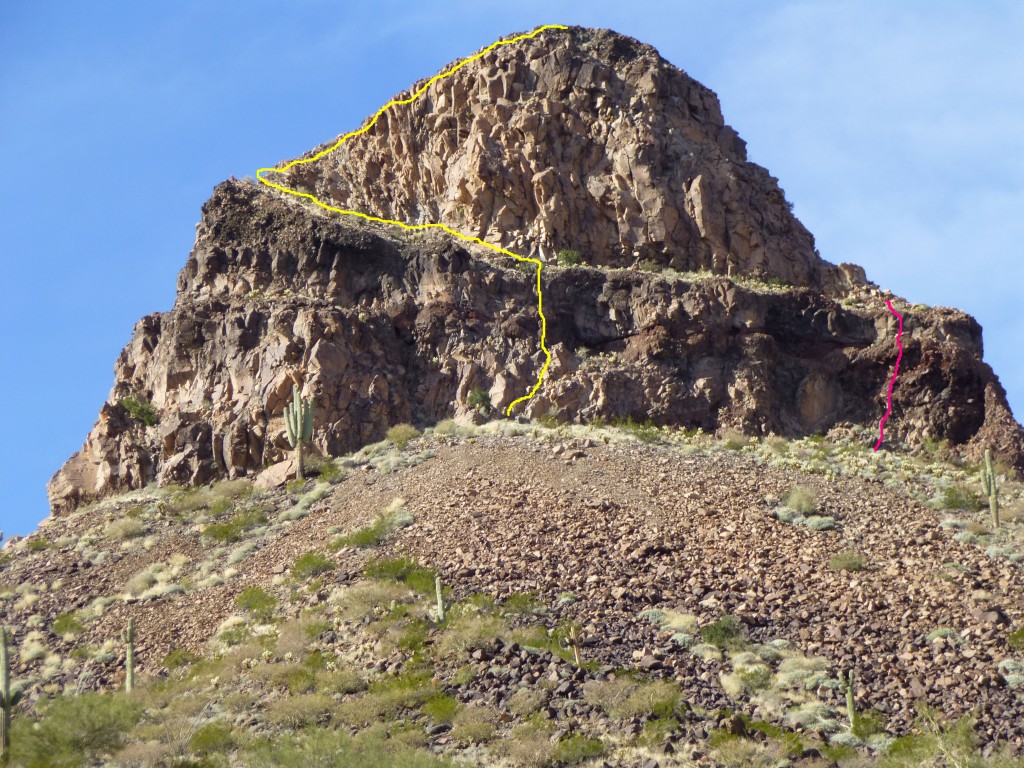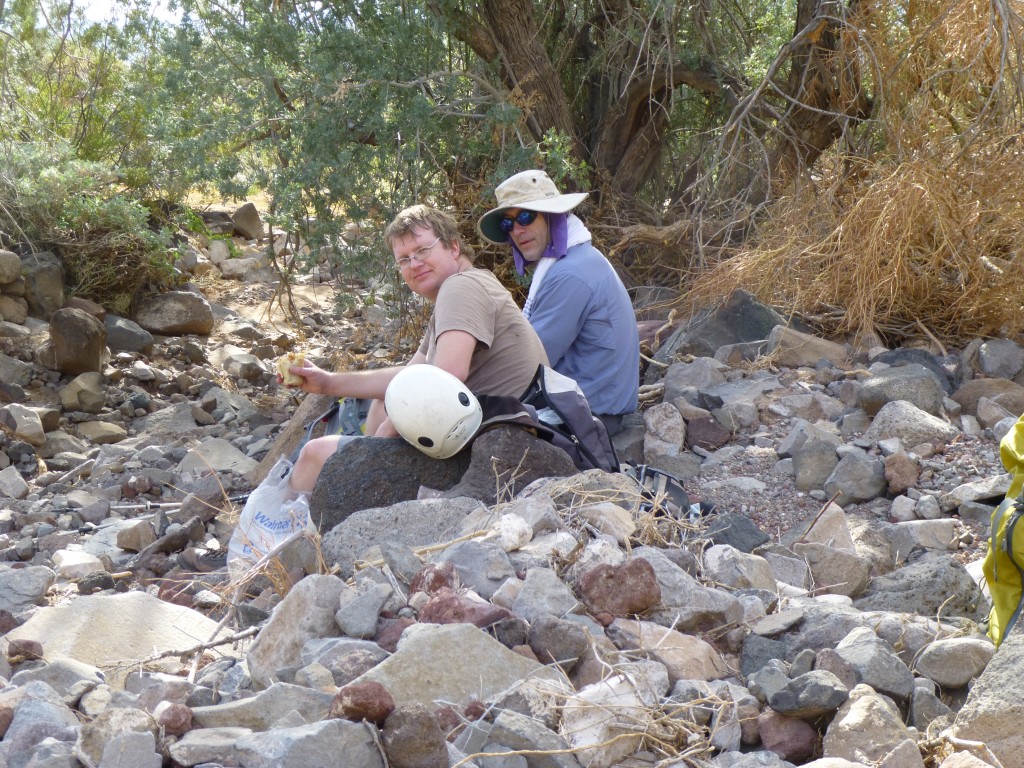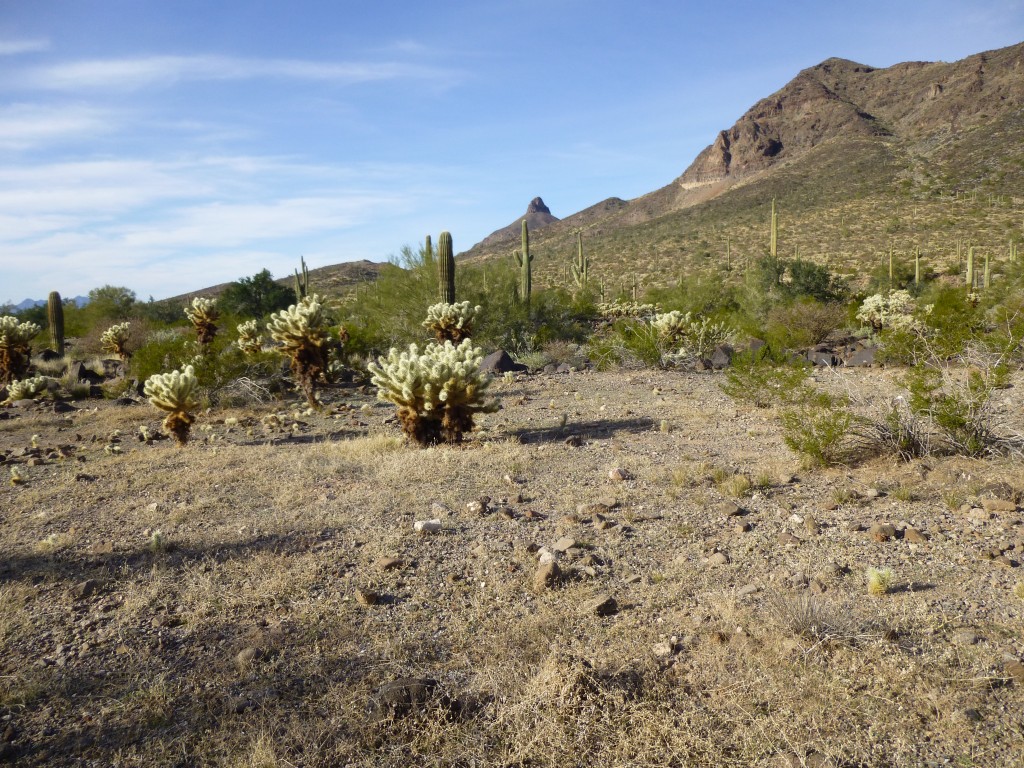A dozen years ago, my California climber friends invited me to come with them to try a peak in the Growler Mountains, but I reluctantly declined. Sheep Peak, a striking mountain on the west side of the range, had caught their eye. Nobody knew anything about it, but they made the trek into the area and climbed high up on its eastern slope. Two of the party were accomplished rock climbers, but without technical gear they couldn’t risk an attempt on the steep rock of the summit.
Years passed. As 2013 wound down, I found myself deeply committed to a large mountaineering project. As part of that, Sheep Peak popped up on my radar. Late in the year, Andy Bates, one of that original party, agreed to guide me to the peak and lead a climb up the thing. We started for the mountain at around 8:00 AM, and by the time we were roped up and ready to climb, it was noon. We put in two short pitches, but after Andy led the second one, he had a hard time finding good placement to set up a safe belay stance to bring me up. He checked out the route farther up and, unroped, made it to the summit. We were running out of time. Andy knows how much I hate being benighted in the middle of a technical climb, and since that was what we were facing, I asked him to abort.
He set up some bit of pro and I lowered him down to me. From there, we both rappelled down to the base of the climb. As much as it broke my heart to walk away, it was the prudent thing to do.
By the time we had gotten down from the steepest part of the mountain, night had fallen. We walked for hours by headlamp through miles of desert to make it back to our vehicles.
As 2014 wore on, I realized that Sheep could easily prove to be a stopper for my project – I needed more than ever to summit. Once again, I called on Andy. He seems to be the go-to guy for several of us in our area when we need to get to the top of something technical. He very graciously agreed to lead another climb, even though it’d be his third time in there and he’d already summited once. He invited our friend John Klein along. John, like Andy, is strong and fast, and it doesn’t hurt that he’s also a surgeon. We’d be a party of three then, it was settled.
Our appointed time arrived. On December 19, 2014 I drove from Tucson to the Ajo area. I climbed a small peak early in the afternoon, then drove the at-times rough road to within a mile of Charlie Bell Pass and watched the sun go down. Talk about throwing a few hurdles in our way – we had picked the shortest day of the year to do the climb, as well as a new moon. Oh well, it was the only day that’d work for Andy, and we happily arranged our schedules to jive with his. John arrived at 8:30 PM, and Andy at 10:30. We parked together and got some shut-eye.
In the middle of the night, a vehicle drove by us at a speed that was way too fast for that road, then returned past us a while later. Drug smugglers would be the only ones pulling such a stunt. Nothing we hadn’t seen plenty of times before, so back to sleep. My alarm rudely went off at 2:30 AM. I roused the others (we each slept in the backs of our trucks), we prepared our gear and then convoyed up to the pass. Once there, we parked under the dreaded flashing blue beacon. It’s set up so that undocumented border-crossers who have decided to throw in the towel can make their way over to it, press a button, then wait for the Border Patrol to come and rescue them. You can see it for many miles at night, and it’s so bright that it’ll make you crazy if you foolishly camp near it.
By the time we shouldered our packs, heavy with the usual stuff as well as all the climbing gear, it was 4:00 AM and pitch black. Perhaps around 40 degrees, it wasn’t as cool as it might have been, and it was pretty easy to stay warm carrying those packs. I chuckled as we set out – Andy had decided to have salad for breakfast. He ate it with a plastic fork out of a plastic dish as he walked, which was no mean feat, as we started out by dropping hundreds of feet through rough terrain. Less than two miles later, we reached Charlie Bell Well, a reliable water source – we didn’t stop, as we were carrying plenty. About a mile after that, it was time to leave the rough road and set out cross-country.
It was truly dark, the only natural light being that of the stars, and that was certainly not enough by which to navigate. Even so, they shone with that incredible brilliance for which the desert is famous. Thank God for GPS – without it, it would have been almost impossible to keep on track. The path to the mountain was across the grain – that is to say, we had to cross many gullies, some of them quite deep and steep-sided. All three of us had our headlamps on – without them, we couldn’t have dodged all of the cacti and the many other sharp, nasty things that populated the desert. Our route headed generally north, taking us eventually to a major gully which we followed for a bit, then left it to climb up through a set of cliff bands. That done, we stood 600 vertical feet below the summit. The first light of dawn was now apparent, just enough to see by. Four hundred vertical feet of steep talus slope was the next challenge. It wasn’t the type of talus with big pieces that is nice and stable; rather, it was small bits, very loose and frustrating to climb up through, with a lot of back-sliding. It took a lot of effort, and by the time we reached the base of the rock which forms the summit block, we were soaked in sweat. It was now about 7:00 AM and broad daylight.
So, it was déjà vu all over again. There the three of us stood, in the same spot Andy and I had been a year earlier. Two hundred feet of rock towered above us, and the issue was still the same – we needed to climb it. There was so much effort involved in attempting this peak that I never wanted to come back again, ever. The previous year, Andy and I had scouted out a possible alternative route, but upon closer inspection, we ruled it out – the climbing looked even harder and the rock poor. The route we had tried the year before seemed the only possibility.
As we put on helmet and harness, the sunlight finally reached us, and it felt good.
Andy set out with John belaying him. He moved up quickly, stopping only briefly to place one piece of protection – a sling around a horn of rock.
Andy had decided to combine last year’s two pitches into one, so once the pro was in place, he moved on up. There was a tricky bit, about Class 5.6, which he breezed up, and shortly after arrived at a large ramp. This was the same ramp he had reached the year before, but had been unable to find any way to place good enough protection to set up a safe belay to bring me up to him, and we ran out of time.
John took Andy off belay. He was a hundred feet above us and hidden from view, so we kept in touch with a pair of FRS radios. Time passed. John and I solved many of the world’s problems while Andy worked on solving the same problem he had faced the year before, a lack of ways to place protection to create a solid belay stance to bring us up. More time passed. Finally, a full two hours after he had started climbing, he radioed us and said we could climb when ready.
At this point, I would like to share with you Andy’s description of the route and what he went through to make the climb safe. His words are all italicized and make up the next two paragraphs. My own description continues after that.:
The only piece of protection on the climb was an 8 ft sling draped over the edge of a 2 ft ledge /horn of rock at the top of the easy 3rd to 4 class rock, maybe 25′ up, just before the real climbing began. It did little protecting, as it really only served to stop me from hitting the ground initially and not the ledge itself or the nearby bowl filled with chollas. I did not place any other pieces, as the rock quality didn’t really afford them, nor did I feel the need, as I already knew what to expect above and preferred to simply climb through it quickly.
I spent a good long time on the ramp, searching for a good anchor. If a good one existed, I probably could’ve gotten you up on our first attempt the year before. I also was limited on what I could use until I cleared the area of some incredibly unstable rocks, an option we didn’t have the year before, as you were stuck tied in at the cholla bowl, halfway up the pitch. I explored several cracks and other rock features, searching for anything that would provide some security. The few cracks that did exist typically would break apart with small effort due to the nature of the shale-like rock. A nice deep, long crack feature existed 15-20′ above the ramp that would have served well for a couple cams, but getting to it proved quite tricky. Some unprotected moves on more loose-looking rock got me within 5′ of it, but I abandoned it for something more practical. The down-climb of that exploration proved harder than any other climbing I did for the day. The final anchor set-up included 2 small to medium wired stoppers (spaced closer together than preferable) in a small, but stable crack, backed up by a sling tied through the roots of a nearby elephant tree. Fortunately, I was able to sit in a solid sitting position to belay from. Despite this, I did not trust this as a rappel anchor, and we went to the north some ways to locate the one solid boulder on the ramp as a more secure rappel point.
I was next. The pitch went quickly, even the crux. There was plenty of loose rock to avoid, and a few dreaded teddy-bear cholla. The pitch was about 100 feet long. When I climbed up over the lip and could see Andy, I was surprised at what I saw. He had described the ramp and the rest of the climb to me after our first attempt, so I’d had a year to wonder about it. I still wasn’t quite prepared for what I saw.
The ramp varied in width, anywhere from five feet to as much as twenty feet, so it was wide enough alright, but it sloped upward steeply and also sloped outwards steeply down and away from the cliff face. Another thing – the ramp was covered with a layer of flat pieces of rock which slid easily underfoot with any pressure on them, making the entire ramp very loose and dangerous. Once Andy brought me up, I unroped and found a safe spot to sit and wait. Andy tossed the rope down to John (it took two tries, having hung up partway on the first try), who tied in and quickly climbed up to us.
There weren’t any big rocks that Andy could have tied in to, so he had to use the cliff face behind him. It had an interesting conchoidal fracturing on a large scale, with few cracks in which to insert protection.
Before Andy brought us up, he had asked us to move well away from the start of the climb, as he wanted to remove some of the loose rock where he was trying to set up his belay station. From a safe distance, we watched him toss down a great many pieces of rock. These missiles flew down for a long while – mainly, he was concerned they could slide down on to us from above as we climbed, as even a slight touch of the rope could start them sliding.
Now that we were all together again, we climbed up the steep ramp to its south end, where it abruptly ended.
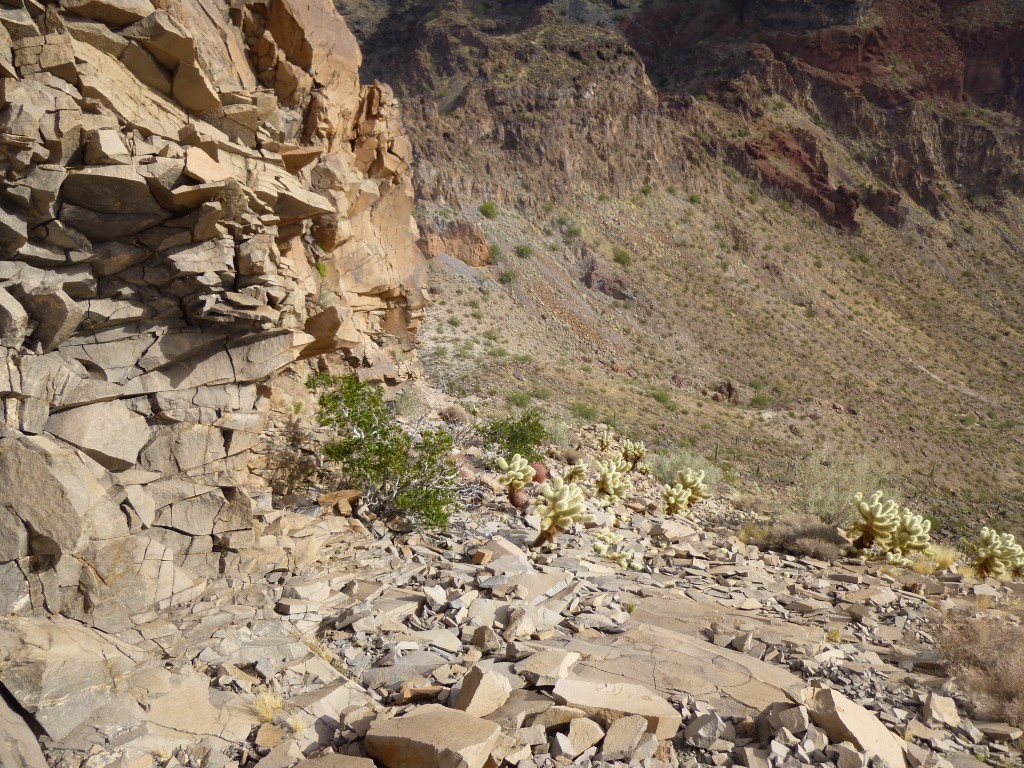
Looking back down the ramp. It curves to the left and out of sight around the corner. This picture gives no sense of the drop-off over to the right where we climbed up.
All that remained for us to do was to make a sharp turn and head back to the north, up the steep, narrow summit ridge.
The climbing was easy, just Class 2, but the exposure was breathtaking, especially on the west side. We carefully made our way up this spine, and after perhaps 200 feet, it leveled off and there we stood on the summit of Sheep Peak, elevation 2,217 feet.
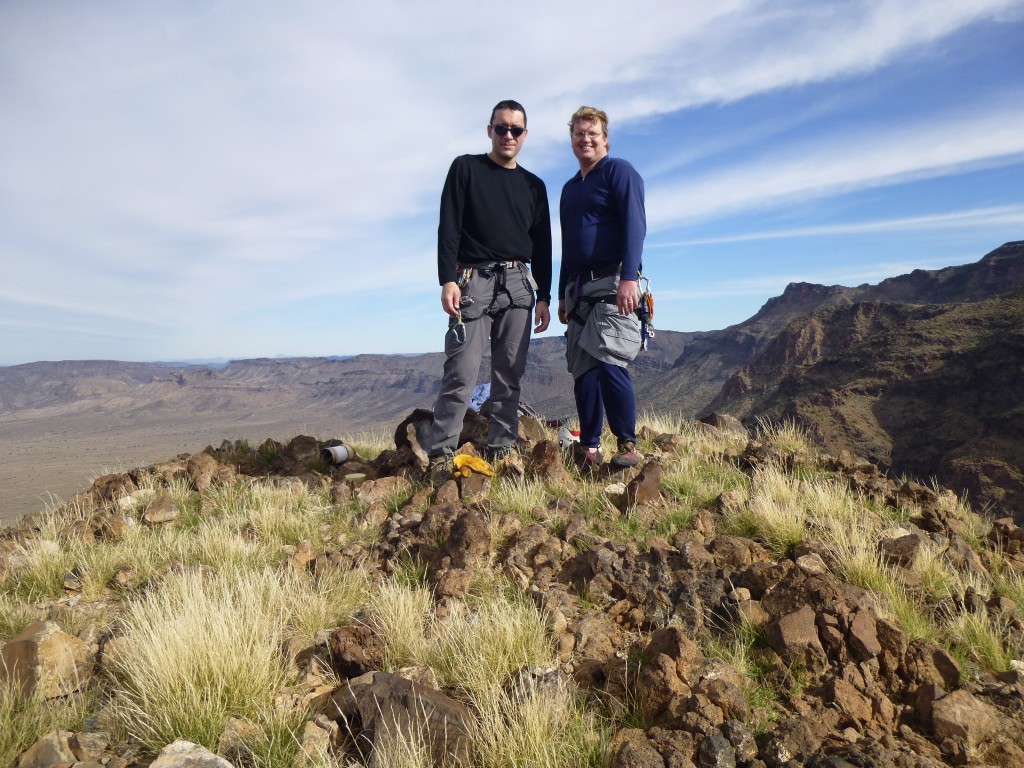
John (on the left) and Andy on the summit. The cairn is hidden behind John, and the PVC register is to the left of him on the ground.
It was now 10:50 AM – we had left the trucks seven hours earlier. There was plenty of room to move around. We found a small cairn left by some previous party, and in it lay a piece of white PVC plastic pipe, maybe 6″ diameter and 12″ long. Andy had seen it the year before, and when he had opened it, found some papers that were soggy and illegible. The cement holding the end cap in place had failed, and the papers inside the pipe were so soggy that they were degenerating into a black, slimy blob. We felt there was no hope of ever being able to read anything that may have been written on the papers, so, sadly, we left them inside the ruined register. The mystery is still safe. We had a register of our own, which we completed and left in the cairn.
What a magnificent perch! The views were amazing in every direction – perhaps my favorite was seeing the Granite Mountains across the Growler Valley.
Now that we had stopped moving, the wind on the summit felt chilly. After lots of photos, we started down, carefully negotiating the narrow ridge that led us back down to the ramp.
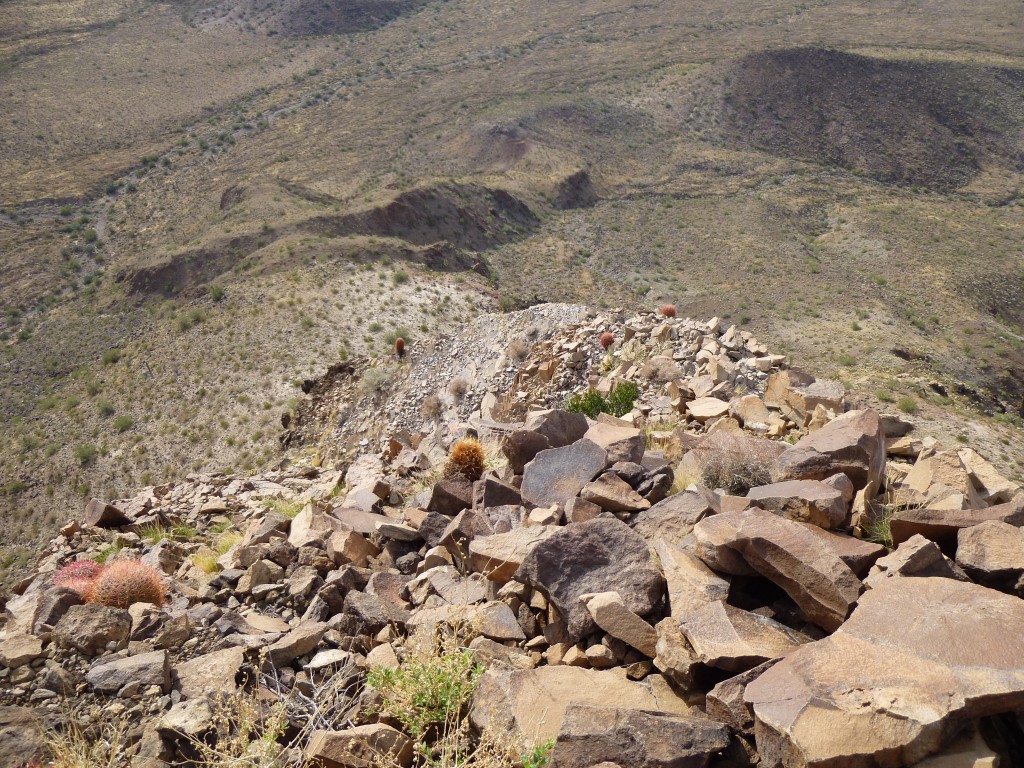
Looking back down the ridge. The ramp appears as a grey streak angling up from the left to the center of the photo.
Back at the spot where Andy had belayed us up, we gathered our gear, coiled the rope and removed our protection. Andy had found a spot farther down the ramp, at its very end, in fact, that he thought could serve as a sound rappel anchor, so there we went. We put a long piece of webbing with a rappel ring around a large, immovable rock, and threaded the rope through the ring. While waiting for them to set up the anchor, I noticed these unusual rock formations across the valley.
Andy tossed the rappel rope down, one half at a time.
I, being the weakest member of the party, went first.
The rappel had a long approach, so stepping over the lip was comfortable. I dropped down 15 or so feet to a ledge, then backed off of that and over another lip into a great overhang of 30 feet. The rope was 70 meters, or 230 feet. When I reached the bottom, ten feet of doubled rope remained, so the rappel was 105 feet. John came next, then Andy. We were down.
We walked south along the cliff face to where we’d left the rest of our gear, loaded up and said goodbye to Sheep Peak. Down the talus, then the cliffs, and into the big gully. Here’s a look back up to the peak from the area of the cliffs.
Here’s a telephoto shot from the same place. I’ve drawn our climbing route in yellow. Our rappel route down from the ramp is shown in pink.
We stopped for some lunch and savored our climb.
The next few hours were spent walking through the desert and soaking up the perfect 65-degree day.
The slog up from Charlie Bell Well to the pass done (I don’t think I’ll ever have to do it again), we were all back at the trucks by 4:18 PM. The climb had taken just over 12 hours – it’s hard to do it any faster. I was glad it was over. Don’t get me wrong, I’m glad to have done it, but it’s a bit too much work for my liking. Sheep Peak is still sitting out there, waiting for other climbers, so go have some fun with it.
Please visit our Facebook page at: https://www.facebook.com/pages/Desert-Mountaineer/192730747542690

